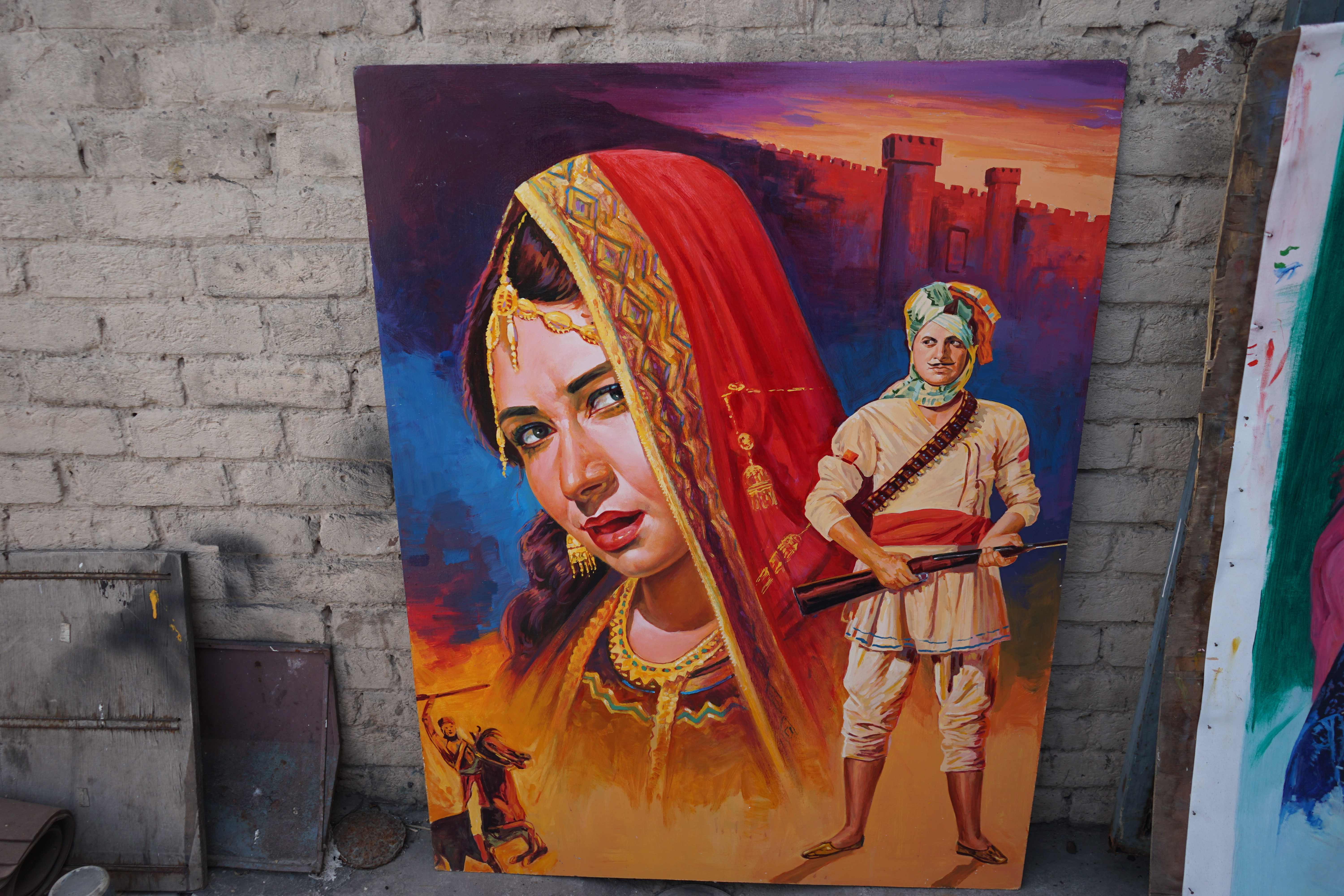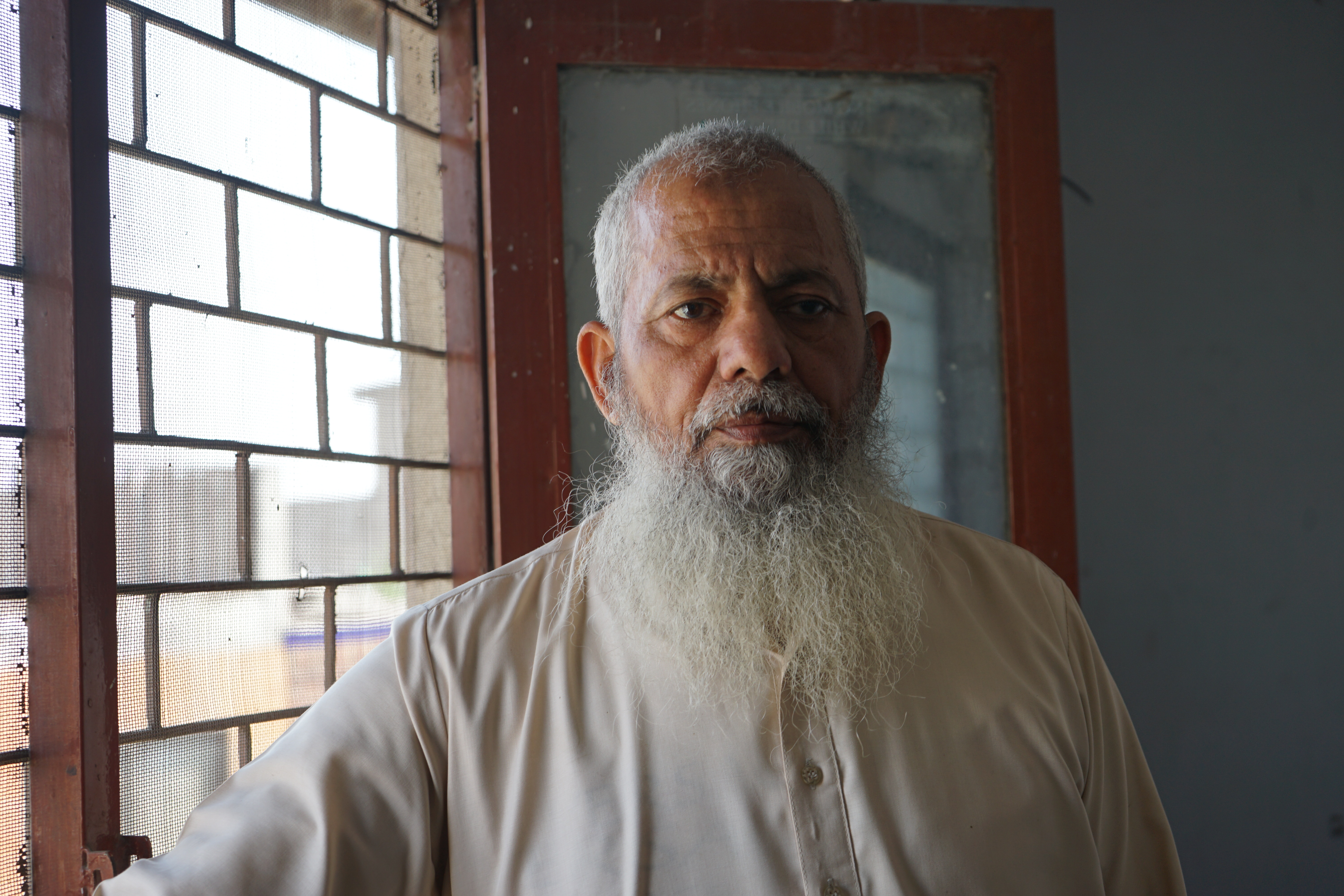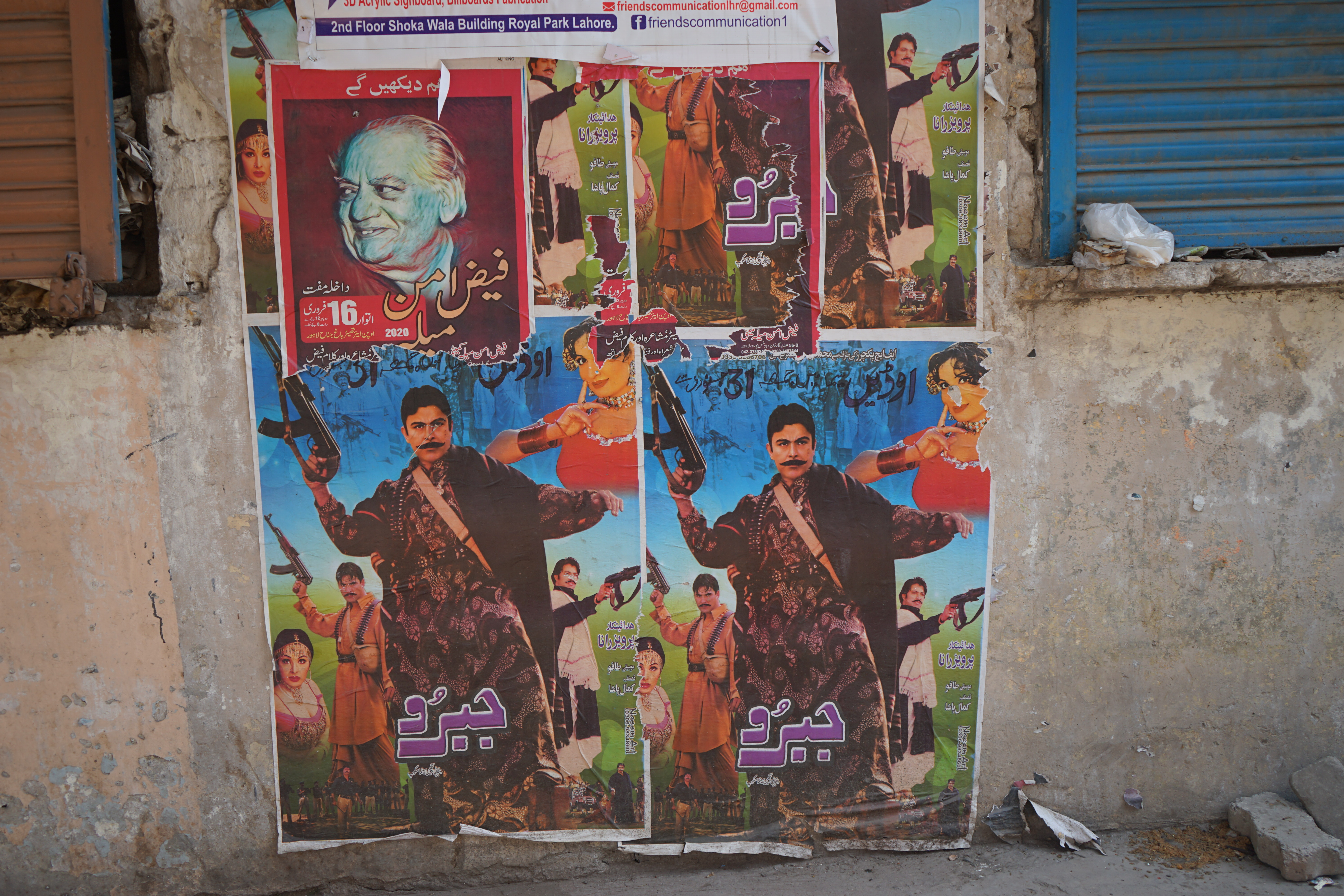On a Sunday morning in April, our rickshaw arrived in front of a four-story building in Lahore’s historic Royal Park area. (1) At its height, the area was a bustling film hub with production offices, advertisers, and distributors. Only a few of those businesses remain, tucked into a warren of streets dangling with electric wires and polychromatic film posters. The artist Muhammad Ajmal, wearing a beige shalwar kameez , unlocked the door and led us to his workstation on the rooftop, arranging plastic chairs in a room crowded with tubes of paint, plastic bottles of Coca-Cola, and a bulky Sony TV. In one corner, a canvas board displayed an armed figure wearing a turban and khaki dress. In the background, a film heroine, draped in a red scarf trimmed with gold, gave the viewer a flirtatious glance.
In the 1970s and 80s, Ajmal’s hand-painted cinema posters packed Lahoris into theaters. Loud, striking, and exploding with color, the posters were typically larger than life, featuring exaggerated characters on displays sometimes topping 100 by 20 feet. Ajmal has painted posters for popular Pakistani films like Aslaha (Weapon) and Aanchal (Scarf), as well as a string of American blockbusters like Godzilla and Jurassic Park. “There was a time when all the famous cinemas in Lahore had their exteriors painted by me,” said the 55-year-old.
In South Asia, film promotion was once a moving art—posters were wallpapered on to motorized rickshaws and horse-drawn carriages known as tongas. The visual landscape of Pakistan used to be dominated by these posters, with skylines dotted with energetic, brash, and violent images from the latest Lollywood movies. Unlike in the U.S., where posters competed with TV, print, and radio ads to sell tickets, in Pakistan, the posters were the main—and cheapest—mode of advertisement. “They would tower over the city, giving the film the impact that it wanted,” said Ali Khan, an anthropologist at the Lahore University of Management Sciences (LUMS).
By the 1970s, Pakistan was home to one of the globe’s largest film industries, averaging more than 100 films a year. At its apex, hundreds of artisans crowded workshops on Lahore’s streets to paint film posters, trained by ustaads (masters) who instructed teams of students. Before the advent of digital printing in the 1990s, the heroes and villains of Pakistani film were introduced to the public through these ostentatious boards, from the Lollywood legend Rani to the Punjabi film actor Sultan Rahi. “People were able to imagine the characters because of us,” said Ajmal in his studio.

Like other artists, Ajmal distinguished heroes from villains by assigning them distinct color schemes. Lead characters were painted with meetha, or sweet, colors like red, blue, and orange to help them pop on the board. “You have to make sure the hero stands out,” Ajmal said. Studios would send him a book of still images and ask him to run wild with his imagination. “No one told me how to make the poster,” he said. “Hand-painting is a real art; it takes a lot of labor and attention to details, something which digital printing lacks. The computer is just like a monkey; you give it instructions and commands. There is no creativity behind it.” When Pakistani theaters were booming, the studios offered him free tickets to watch movies he painted, though he rarely went. “We were so busy painting posters and cinema exteriors that we didn’t even have time to watch movies,” Ajmal said.
Today, however, there’s been a precipitous decline in hand-painted posters across Pakistan, thanks not only to cheaper digital printing, but to an ailing film industry that only produces about 40 films annually. With only about 120 screens in a country of 220 million people, the closure of cinemas has spelled the demise of poster making, and the inability to screen Bollywood films has accelerated the end of many old cinema houses displaying movie posters. Although Bollywood generates roughly 70 percent of the revenue for Pakistani cinemas, its films are routinely banned whenever tensions flare over Kashmir, most notably during a 40-year period after the 1965 war over Kashmir. Early last year, after skirmishes on the Pakistan and India border escalated in the disputed territory, Pakistan banned Indian films again. With the restrictions still in effect today, the impact on cinemas has been disastrous, said Gwendolyn Kirk, an expert on Pakistani cinema at LUMS: “All the theaters are bleeding money because they don’t have enough viewers.”
The number of artisans laboring at this craft has dwindled to fewer than a hundred. And while Ajmal still produces on-demand paintings of old films, it’s a challenge to survive. Now, a younger generation of Pakistanis are encountering hand-painted posters not in movie theaters but in modern cafes in Lahore or Islamabad. There, provocative slogans like “Honour Kill This Sucka” from the 2000 Pakistani film Jatti Da Vair (Brother of a Jatt Woman) have found new audiences. “It’s the humor together with the image that seems to click,” said Omar Khan, the owner of the Hot Spot Cafe, which has been commissioning artists to paint posters since 2001.

“The previous generation said it’s crude and vulgar,” Ali Khan explained. “The posters have now become more acceptable and owned by people of younger generations. It would never have occurred to audiences that we should preserve this heritage—we don’t even preserve the films.”
Indeed, two years after the country’s founding, in 1947, the minister of industries, Sardar Nishtar, declared that any association with film would lead to moral decay: “In principle, Muslims should not get involved in filmmaking. Being the work of lust and lure, it should be left to the infidels.”
That hostility carried into the Islamization era of Zia-ul-Haq, Pakistan’s infamous military dictator who banned rock music and dancing on TV, and required filmmakers to hold a formal academic degree and register with the Ministry of Culture before undertaking any project.
Under Zia, “there was one requirement. The posters shouldn’t be vulgar,” Ajmal remembers. In 1988, he designed the poster for the Punjabi film Hakoomat (Government), featuring a suggestive pose by two female characters holding a banana and an apple. “The public was outraged. Police had to intervene and I had to take down the whole painting.”
During this time, more than 500 films were banned, and film inspectors were sent to cinemas regularly to check whether owners were playing films censored by a 1979 ordinance that outlawed movies “prejudicial to… decency or morality.” Kirk said that during Zia’s time, studios skirted this by providing one “clean” film to the censor board and playing another in theaters. In those days, there was a common trend of inserting racy or controversial shots that would titillate audiences. “You could tell from the vibrations of the theater that an illegal shot was playing,” said Naveed Akhtar, a film producer in Royal Park.
Akhtar still remembers when his family screened illegal shots from the 1974 film Khatarnak (Dangerous) in their Lahore theater. “The movie became a super hit,” Akhtar said. It was banned three times. “When it was censored and scenes were cut, the public lost interest and stopped attending showings.”
Despite Zia’s assault on culture and art, the 55-year-old painter Sattar Masih, otherwise known as Mohsin, views the dictator’s rule as a golden era for painters, flush with money and commissions in the Punjabi film industry. While Urdu cinema was strangled by the new rules, Punjabi cinema thrived under Zia due to its willingness to focus on violence, caste tensions, and communalism.
In particular, the new Punjabi cinema culture glamorized violence, and posters of the era featured daggers dripping with blood and men wielding the gandasa, a type of thin, wide-bladed weapon common in rural Punjab. Public punishment for immoral behavior became routine, and Zia sought to amplify the spectacles of violence in a public theater—public floggings sometimes saw a microphone placed before the victim’s mouth so anguished screams reached everyone. Violence served a dual function as a tool for moral instruction and entertainment, and filmmakers embraced the new cinema culture of violence during Zia’s 11-year dictatorship, knowing that films were much more likely to be censored for sex.

Rural and working-class Punjabis also began entering theaters en masse thanks to the depiction of a new hero unlikely to provoke Zia’s ire, one that was uneducated, unruly, and devoid of overt political questions. In 1979, the Punjabi film Maula Jatt exploded onto the scene, starring the actor Sultan Rahi (billed as the Clint Eastwood of Pakistani cinema) as the titular character, wielding a gandasa and trying to settle a family feud in his village. However, it too faced Zia’s censors, and the general attempted to ban it for being too violent. (The producer managed to delay the ban for over two years, during which time the movie became a hit.)
Likewise, Mohsin learned the public’s judgmental eye could be worse than Zia’s censors. In the 70s, Mohsin painted a poster for The Mighty Peking Man featuring a girl in her underwear. Backlash from the religious right forced him to paint over the offensive image. “If you didn’t do this, they’d rip it off and set it on fire,” Mohsin explained.
With some Muslim leaders pelting rocks at “obscene” posters, artists quickly developed a sensitivity toward the public’s reactionary outlook. When Mohsin painted the poster for the 1972 Urdu film Naag Muni (Cobra Worshippers) in Faisalabad, the Islamist group Jamaat-e-Islami threatened him for drawing the lead actress with exposed arms. After that, Mohsin asked cinemas to move posters with nudity away from the public’s eyes to avoid attacks.
Today, Mohsin’s work has moved from cinema houses to the domain of private art collections and upscale restaurants, while Ajmal sells the posters he makes on-demand for approximately 50,000 rupees ($300). Near the capital, Islamabad, the popular restaurant Des Pardes features a rotating gallery of his artwork for films. The manager, Muhammad Zubair, said the hand-sketched art holds a unique allure for customers—indelible, eye-catching posters stay with customers long after they leave. In 2004, Hot Spot’s owner, Omar Khan, commissioned Mohsin to paint classic South Asian film posters for a film festival in Switzerland, including the 1976 film Naag aur Nagin (Snake and Female Snake); according to Khan, it was purchased by the film director Dario Argento.
“People were not snickering or laughing, there was genuine appreciation,” Khan said. Whereas Pakistani posters were once viewed as gaudy and ostentatious, the posters Mohsin had painted over the years were now ironically trafficking in the currency of nostalgia, memory, and fantasy. The indigenous art form has transformed into a new commodity, printed onto mugs, T-shirts, and pillowcases. It’s somewhat ironic that an artist’s film posters have only been, as the anthropologist Arjun Appadurai puts it, “enhanced by placing objects and things in unlikely contexts,” a concept he calls “commoditization by diversion.” The classic posters artists paint are perceived as having more artistic merit, even if their utility and function have diminished. The artist is no longer attempting to help cinemas sell tickets—posters are now collector’s items with their own aesthetic value.
But Mohsin still yearns for the steady pace of work he found when Punjabi cinema flowered in the 70s and 80s. “Our work was better under Zia,” he said. And despite the decline of the film industry, many artists are reluctant to leave their work behind. Ajmal is nostalgic about the posters he illustrated in the early years of his career, but the names of the films and stars he painted have already begun slipping from his memory. “All of it is gone now,” he explained. Lahore’s gargantuan billboards are now nothing more than flashy digital screens advertising the latest fashion brands. Luckily, the indigenous art form he helped popularize still survives on his paintbrush, if not in the cinemas.
1. We visited Ajmal twice. On the first occasion, before the COVID-19 lockdown, he was dismissive of the fact that Sabrina and I were wearing face masks, but on the second occasion, Ajmal greeted us by wearing a face mask of his own. Ajmal was also quite reluctant on the second occasion to come out of his home because of COVID-19. As we entered his studio he remarked that with the exception of Islamic holidays like Eid, he had never seen Royal Park so deserted.
All the theaters we visited in Lahore were shut down by the government thanks to the coronavirus. We were able to enter the theaters to take photos but were always told to leave. As we entered Shabistan Cinema, I greeted the staff with a bow and "namaste" sign, choosing not to shake hands to maintain social distancing protocols. Offended, one staffer began complaining that COVID-19 was a conspiracy against Muslims to shut their mosques.
We also tried to visit the hand-painted movie posters at the Hot Spot Cafe, but all restaurants had been forced shut by the government. As soon as we attempted to open the door of the cafe, the mask-wearing waiters stuck their hands out and told us to leave.
Follow Sabrina Toppa on Twitter.
from VICE https://ift.tt/2XwKRdq
via cheap web hosting
No comments:
Post a Comment